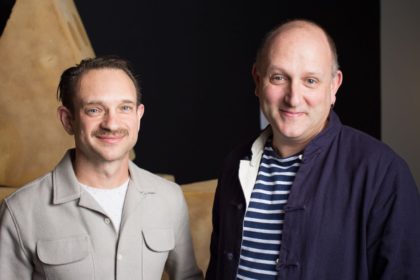 R & Company has come a long way since Evan Snyderman (above left) and Zesty Meyers began selling midcentury furniture at an East Village flea market in the late 1990s. Under the name R 20th Century, there was a store in Williamsburg, and then—as the company’s focus broadened to include contemporary design—a move to Tribeca and a renaming. Now, R & Company is celebrating its 20th year in business and preparing for a spectacular expansion on White Street. “Since day one, we’ve never sat idle,” says Snyderman. “We’re always pushing to the next level.”
R & Company has come a long way since Evan Snyderman (above left) and Zesty Meyers began selling midcentury furniture at an East Village flea market in the late 1990s. Under the name R 20th Century, there was a store in Williamsburg, and then—as the company’s focus broadened to include contemporary design—a move to Tribeca and a renaming. Now, R & Company is celebrating its 20th year in business and preparing for a spectacular expansion on White Street. “Since day one, we’ve never sat idle,” says Snyderman. “We’re always pushing to the next level.”
How did you get started in this business?
Zesty: It was a hobby. We used to be artists and professional glassblowers. We worked all over the world, together and separately. And we were part of a non-for-profit called the B Team.
Evan: We shared an interest in cool stuff. Old stuff. I’ve been a collector my whole life—I’ve been going to flea markets since I was five. We both collected junk. Cool junk.
Zesty: Some of it was valuable.
Evan: But if you collect, you have to sell, or you can’t keep collecting. In 1996, just for fun, we started selling stuff at the flea market at 11th Street and Avenue A. A friend who sold vintage clothing invited me. Zesty joined me one weekend. We clicked and had a good time. It was just a fun side project, during the height of the B Team.
Zesty: Then it got very serious. We became scholars, researchers, looking into the history of what we were collecting and selling. There were amazing designers, some better known than others. Some became widely known on the secondhand market.
Evan: It was an interesting time—there were few books on midcentury design, and no Internet. We didn’t go to school in this. We taught ourselves: We learned from pickers and dealers, and we collected books. The beauty of there not being a lot of information out there is that it means better access: We’d go to flea markets and house sales, and people didn’t know what they had. We’d find amazing stuff on the street.
Zesty: The stuff getting thrown out in the late 90s was crazy!
Evan: Design skips a generation. The parents of the baby boomers bought great furniture after World War II, but the kids who grew up with it wanted something different. When the parents died, it got thrown away.
Evan: Before we opened the store, we went to Scandinavia. There was stuff everywhere.
Zesty: We’d have to make hard decisions about what to take. We’d fill a container and 85 percent was the super-best of the best.
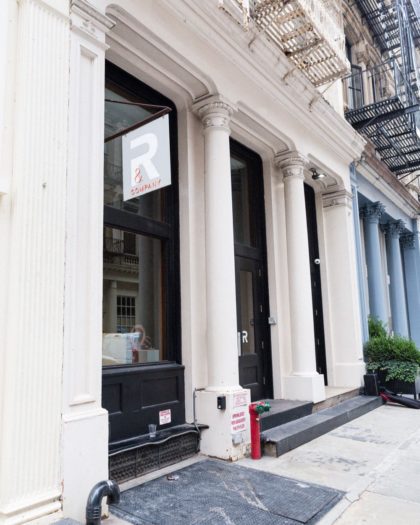 When did you open the store?
When did you open the store?
Evan: We opened in Williamsburg in 1997. We didn’t intend to have a store. It was a warehouse for storage.
Zesty: We used to take photos of every piece and put them in an album to take to the flea market. There was no other way to do it back then! But people were begging to see stuff. We were supposed to be open one day a week, but we had to be open every day. People started writing about us—the New York Times, Wallpaper. Before we knew it, Town Cars were pulling up. It just took off. Because we were artists, not just businessmen, we worked on presenting it.
Evan: We built pedestals, really curated it. Ours and the other shops in the area became a destination. But we realized that we had to move to Manhattan to raise the bar. We looked everywhere.
Zesty: We opened here in May of 2000.
Evan: We were actually looking next door, at the space that later became Dune. As we were leaving, we saw that this space was being renovated, and the guy inside said he was the owner’s son: “Go talk to my dad.” But his dad refused to talk to real estate brokers. So we came back the next day on our own. “You look like nice Jewish guys,” he said, and we made a deal.
Zesty: We shook on it. We asked about a contract, and he said, “If you don’t trust me, we don’t have a deal!” He said that if charged us the most he could, we’d only be able to make it a couple of years. Instead, he invested in us and we all grew together—and we’ve been here 17 years. We seem to have good fortune with landlords—our first store, our warehouse, the new space. They’ve all helped us.
Evan: That’s the key to success in New York City, isn’t it?
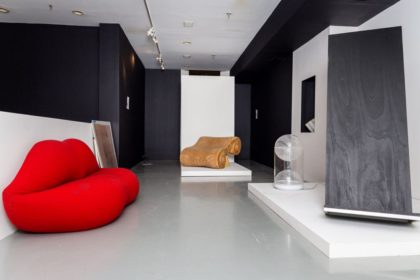 From here out it’s all Evan; Zesty, who lives in Tribeca, had to leave to attend a meeting at Washington Market School.
From here out it’s all Evan; Zesty, who lives in Tribeca, had to leave to attend a meeting at Washington Market School.
What is R & Company known for?
We’re known for curating our own markets in the design world. We’ve established multiple markets over the years—we find something new, something unrepresented. We champion unknowns, and with contemporary designers, we push boundaries.
Where did the “R” in the name come from?
We had just opened our small space in Brooklyn when we went to an auction upstate. We discussed ideas for a name the whole two-hour drive. When we arrived and previewed the sale, there happened to be a 4.5-foot stainless steel-and-neon “R” coming up for sale. The R had come off of the Midtown men’s clothing store Robert Hall, and it probably dated from the late 1940s. It was an aha moment, where we both instantly agreed R would be the name. We had one window facing the street on Wythe Avenue in Williamsburg, and judging from sight, I knew it would fit perfectly in the window.
What’s the most satisfying part of what you do?
There’s never a dull moment around here. We’re always very, very busy. We collaborate a lot—that’s a big part of what I enjoy—with artists, gallerists, collectors, and staff.
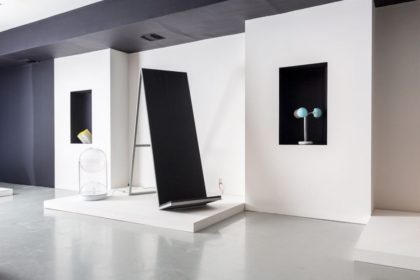 Is there a type of design that people are most excited about these days? Or a designer?
Is there a type of design that people are most excited about these days? Or a designer?
Fifteen years ago, we were discovering Brazilian design, bringing it to the U.S. Now it’s a global market. But back then, no one had ever heard of them. It’s satisfying to grow something beyond our own little world. As for specific designers, the Haas Brothers have become one of the most important contemporary designers in America—they work in lots of different mediums and have a diverse program. Everything is unique and interesting.
What’s the most expensive work you’ve ever sold?
The biggest is probably around a million dollars. That’s nothing in the art market, but in the design world, only a few things around the globe have sold for over a million. Most are under $10,000.
Back when you started out, I bet you never dreamed of selling something for a million dollars.
I remember when we’d both go to deliver something because it was over $100. That was a big deal.
How do you discover designers and artists?
Each designer has a different unique personality and the work has to do with that. They’re all involved with the making and the process—they’re running small ateliers, working in handmade bronze, ceramic, brass, glass…. It’s a hybrid: coming out of the art world, with the association of craft. Each one has a unique way of navigating the field. It makes it special.
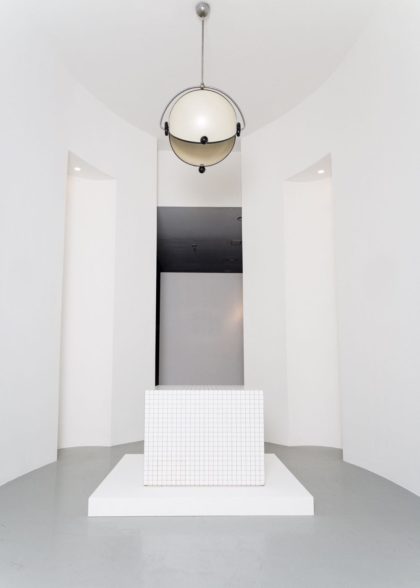 What percentage of your business is local?
What percentage of your business is local?
Surprisingly little. We have some great, great clients in the neighborhood, but I’d say overall the percentage is under 5 percent.
As your market has grown to be international, it would seem natural that the local component would shrink. Tell me a crazy customer story.
Do you know Dale Chihuly, the glass artist? He’s a big collector, and we’ve known him since our glassblowing days. He came in once and plopped down on a sofa and held court with his entourage. He ordered his assistant to get him two chili dogs with cheese and sat there and ate them, with the chili dropping down his shirt. It was great.
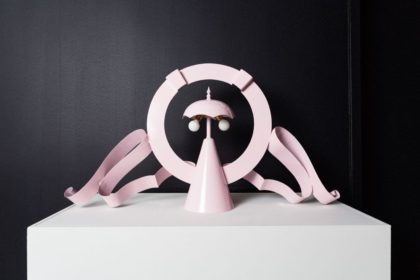 What does the future hold for R & Company?
What does the future hold for R & Company?
The new gallery is an opportunity to really spread our wings. We’ve spent 17 years here, and with 27 employees, we’re bursting at the seams. We’ll be able to promote the work in a new way—to elevate it the way we’ve always wanted to.
When do you expect it to be ready?
We’re hoping to open in the spring of 2018 with our 20th-anniversary exhibition.
Photographs by Claudine Williams, who specializes in head shots for actors, business professionals, or anyone looking to be photographed.










